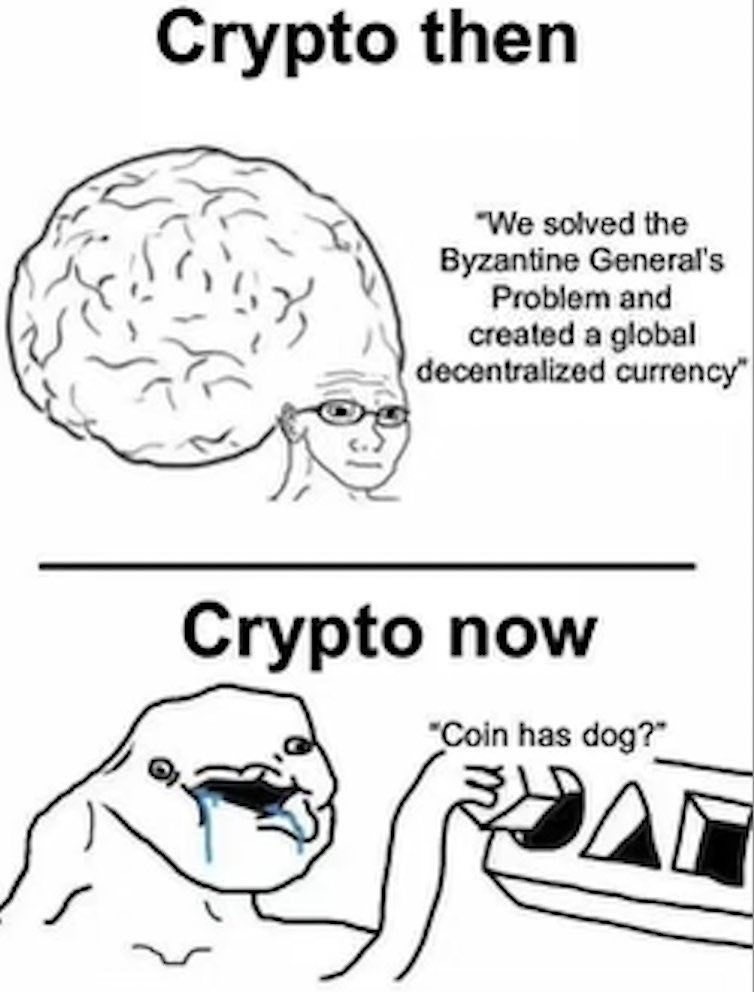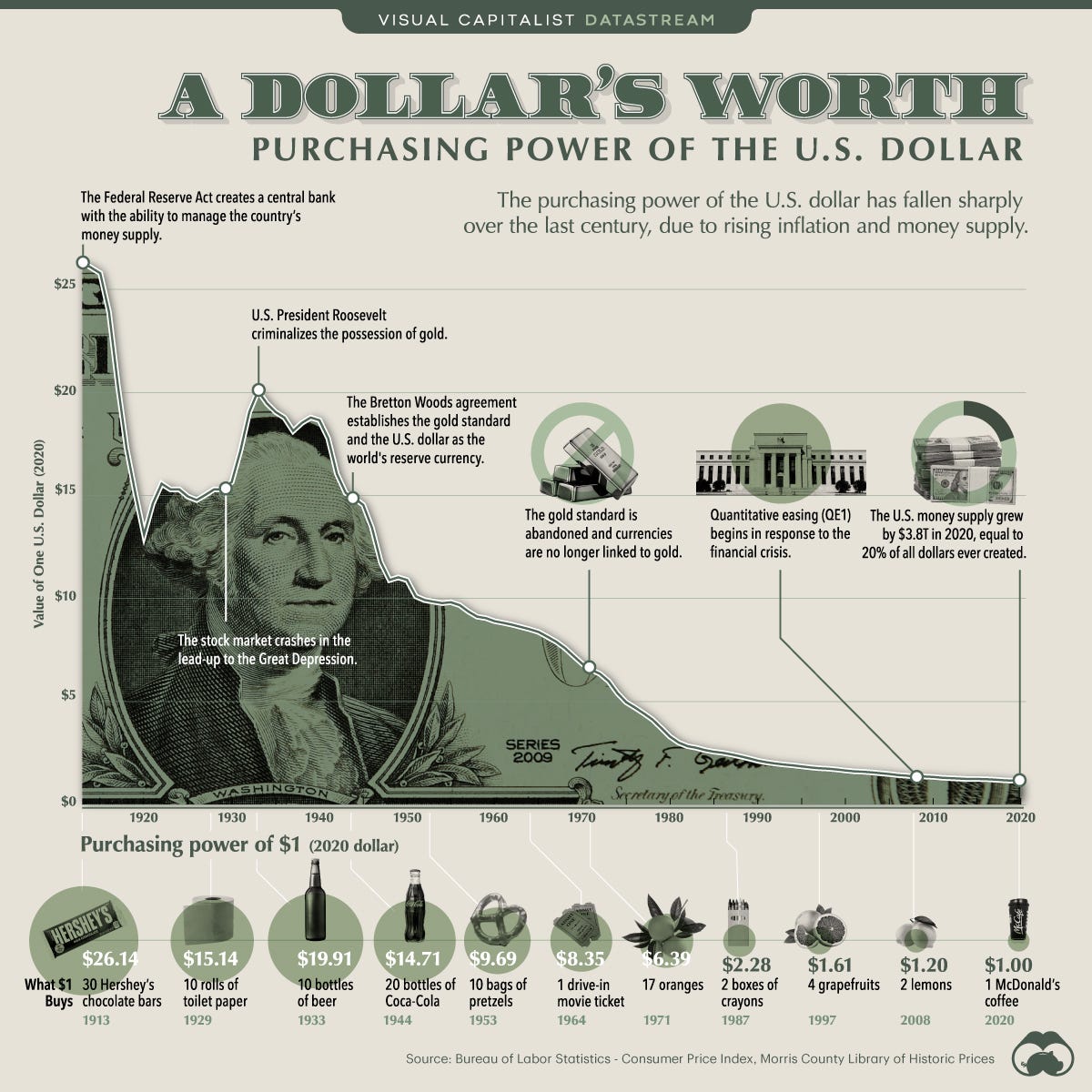I received a number of texts Sunday afternoon from people who were cautiously optimistic about this recent pump in bitcoin’s price. I wasn’t so surprised to receive such texts, as people tend to get “bullish at resistance” and “bearish at support”.
Example of bullish at resistance: “Bitcoin is at $46k; next stop, $2 quadrillion!”
Example of bearish at support: “Bitcoin is at $33k; next stop, negative infinity!”
This is just how it goes. Humans (and I include myself in this, as I’m not immune to the above way of thinking) are funny creatures. You don’t learn these sorts of lessons, though, without having some skin in the game (money in the market), which brings me to the topic of today’s edition of the newsletter: educating yourself once you’ve put some skin in the game.
As I’ve mentioned a handful of times in this newsletter, I bought into a bear market for the first year or so that I got into this digital asset world. It sucked, but I spent that year (2018) buying small amounts of $BTC while I read more and more about the asset. I learned through experience that you can be successful in this game if you can look at bear markets not as a time to capitulate, but as a time to accumulate. To put this in layperson’s terms, most people give up, sell at a loss, and walk away from bitcoin when its price isn’t rising. Ironically, bear markets are the best time to get into bitcoin (or any asset for that matter). If you’re buying something because you’re hearing people talk about it, chances are its price recently went up, and you are in the process of becoming the “exit liquidity”, or the person who comes in to buy when people who have been holding an asset for a while are pumping the asset up as they get ready to sell it.

In 2018, I was the exit liquidity for the 2017 bull market participants. The beauty of an asset as young as Bitcoin, though, is that if you hold it long enough, even if you do buy at a local high (a significant peak in price), you still turn a profit (using fiat as a measuring stick) if you hold it long enough. For example, back in 2018, I bought some of my first satoshis when one bitcoin cost about $10k. Cheap compared to today’s price, yes, but, soon after buying, I watched as the price slid to about $3k. (Again, totally sucked.) But here we are at $47k/$BTC a few years later.
So, if you’ve decided to buy some $BTC or whatever other digital asset because of this newsletter, and if you’ve had the thought, “What’s up with the price? I thought Frank was all pumped about this magic internet money only goes up in value!,” you haven’t done enough homework on this asset class.
If this newsletter is your only source of information on digital assets, you haven’t done enough homework on this asset class. If you haven’t spent at least 100 hours reviewing some of the materials I suggested in this edition of the newsletter, you haven’t done enough homework on this asset class. If you haven’t clicked on some of the hundreds of links I’ve provided in this newsletter and subsequently gone down some rabbit holes, you haven’t done enough homework on this asset class. And if your primary sources of information for this asset class come from the MSM, then, well, your whole brain is broken; my condolences.
Why is doing homework important? Because it leads to conviction (or lack there of). When you do your own research, you gather information to form a thesis. Developing a solid thesis often leads to developing a sense of conviction. Having a sense of conviction doesn’t automatically equate to the price of assets that you have come to believe in skyrocketing to the moon. It just makes it easier to stomach the short-term, sometimes pronounced, downtrends in the market. I have conviction in Bitcoin and DeFi (particularly Layer 1s and their DEXs). I don’t have much conviction in NFTs (I think these are cool for artists; I’m just not a collector and don’t know how to value them), the metaverse (I don’t want to live in a digital world), and play-to-earn gaming (I’m not a dork) because I’m not really into these “sectors” of crypto, and, therefore, I don’t really invest in them.
So, if you are looking for some guidance on where to begin to learn more, I’ll give you some homework. Watch the following two videos (and do the best you can to disregard the stupid tiles for them, especially for the first one):
I was going to re-watch them so that I could better provide you with some key takeaways from them before I had quite a profound thought… “Why would I do the work for you?” Instead, I’ll offer you some advice… pretend you are a horse and pretend these videos are water, and then start drinking. I’ll also let one of my favorite human beings on planet Earth put it another way for you… (watch video from 0:41-0:46)

“If you want something, everything out there is free to you; Google the motherfucker…” -David Goggins
After you watch the two videos, listen to all 25 episodes of Andreas Antonopoulos’s Unscrypted podcast. Maybe even start with this one: “Investing in Education Instead of Speculation”. Antonopoulos is the OG Bitcoin educator. He’s been educating the masses about crypto since way before the days of stupid flashy YouTube tiles.
He began teaching the world about Bitcoin in 2014. He’s a super nerd who speaks like a cross between one of the most knowledgable professors you’ve ever had and a peeved gay man. He also loves to over-pronounce words, which is annoying at first, but you get into it.
If you do the homework above, then you’ll be about 15-20 hours into that 100 hours of independent research. Not a bad start. Feel free to drop what you’ve learned in the comments.
I’ll conclude this edition of the newsletter with a segment from a book I’m currently reading entitled Check Your Financial Privilege: Inside the Global Bitcoin Revolution, by Alex Gladstein of the Human Rights Foundation (I still do homework, too). In the section of the book that details El Salvador’s experiment in making bitcoin legal tender in the country, Gladstein shares his interaction with Jorge Valenzuela, who began selling pupusas in exchange for bitcoin in 2019. Valenzuela admits that he was first quite nervous about being paid in bitcoin, a new currency, as she, like most El Salvadorians, rejected the idea of making the U.S. dollar legal tender in the country in 2001 and regrets the damage that dollarization has done to the country’s economy. However, Valenzuela now has the following to share:
“Remember,” Valenzuela said, “people here don’t have bank accounts.”
“In our communities, we have no financial literacy courses, and no one provides advice to the youth,” Valenzuela said. “But Bitcoin is a great teacher.”
Gladstein goes on to discuss the role that Valenzuela and other community leaders in El Zonte (home of Bitcoin Beach) have played in educating people in their

communities about Bitcoin. Thanks to the group of educators that Valenzuela is a part of, what he calls a “tribe for financial inclusion,”
“kids are not as interested in going to the dark side (joining gangs). They are more interested in the future.”
I can relate to aspects of Valenzuela’s story, as I’ve experienced that sense of hope that came with Bitcoin “clicking” for me, and I highly recommend your picking up a copy of Check Your Financial Privilege (Gladstein) so that you can read Valenzuela’s story in full. (Note: Gladstein is quite critical of El Salvador’s president, Nayib Bukele, despite Bukele’s working to make Bitcoin legal tender in the country; as someone who conducted some research on the ground in El Salvador, Gladstein offers a nicely balanced perspective on what’s currently happening in the country both financially and politically.)
Lastly lastly - even after you do your homework, please keep the following in mind: Despite the institutions that not so long ago told you not to buy cryptocurrencies changing the homepage of their website to the following,
and despite the trash human beings in our government who warned you not to buy cryptocurrencies for the last decade changing their tune,
there will always be the risk of governments trying to “shut down” cryptocurrency, and that risk can come from the right or the left. Trump’s secretary of the treasury, Steve Mnuchin, wanted to stop crypto as much as Elizabeth Warren does. There are going to be hurdles to mass adoption, and some will be gut wrenching according to your exposure, but, I believe, bitcoin/crypto charts will continue to go up and to the right through at least the remainder of this decade,


while fiat charts will continue to go down and to the right in the long run,
as they always have.
In the short run, though, don’t be surprised to see the following:

Prepare/invest accordingly.
Lastly lastly lastly - What I write in this newsletter is what I believe (unless otherwise noted). It’s is not the gospel truth. It’s not a forecast of what’s sure to happen. It’s just the ramblings of someone who’s done some homework after putting some skin in the game.
Best,
Frank
Twitter: @frankcorva












Good read 👍